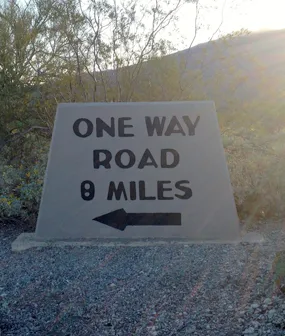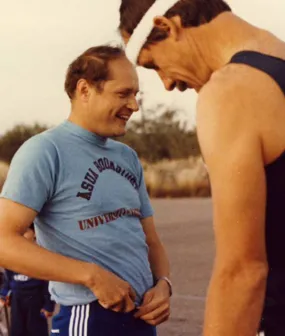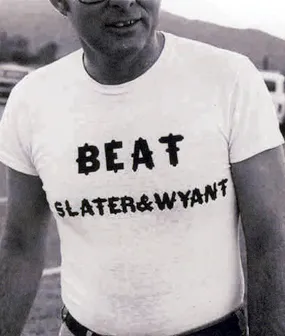"Beat Slater & Wyant"

There are many ways to explore Saguaro National Park East. You could take a scenic drive around the Cactus Forest Loop in the comfort of your air-conditioned automobile, hike along many different paths through the heart of the Sonoran Desert, or go on a narrated “OSC Saguaro Race of 1977” walking tour with Professor Emeritus James C. Wyant. I chose the latter.

Jim: Here’s the starting point of the nine-mile race.
Tammy: The sign says eight miles.
Jim: When they widened the road, they must have shortened the loop.
After some debate over whether or not that was really possible, we began walking. I learned that this particular contest was themed “Beat Slater & Wyant,” and sparked several special-interest wagers; the most infamous being the average time of then-professors Phil Slater and Jim Wyant against the total time of a 10-man OSC faculty relay team captained by Jack Gaskill. I also quickly ascertained that, to this day, Jim still has “somewhat” strong feelings toward the outcome of this race.
Jim: They cheated. Gaskill is a crook. The contract we signed (PDF) clearly stated that the relay team was supposed to be made up entirely of faculty members. Gaskill recruited OSC’s newest Ph.D. graduate — as of two days prior — Bill Sweatt to run the hill.
Tammy: Didn’t you or Phil notice Bill was part of the team before the race started?
Jim: (Stopping and pointing to side of road.) No, they hid him behind THAT bush.

The bush in question was located at the foot of the steepest hill along the road. Jim said that up to that point, he and Phil had a slight lead over the relay team. But when Bill Sweatt came out from his hiding place (wearing the relay team T-shirt with “Beat Slater & Wyant” in bold black lettering) and began running, they immediately suspected foul play. As Jim told me, his “heart sank.” Bill was known to be an accomplished trail runner and the hill would be no “sweat” for him, especially since he had not already run several miles like Jim and Phil had.
After a short respite at THAT bush, Jim and I tackled the one-and-a-half mile hill. As we walked, I pieced together more of his story.
Tammy: There was actually a contract?
Jim: Yes, Jack wrote a very elaborate contract with complicated algebraic summations to define the winning team, outline the wager and determine the payoff.
Tammy: I imagine you and Phil checked the math?
Jim: Absolutely, many times. We were sure there was no way we could lose. But with Bill Sweatt’s help, Jack Gaskill, running the final leg for the pseudo-faculty team, crossed the finish line first.
Tammy: You mean they won?
Jim: I wouldn’t say it that way. They cheated. Gaskill is a crook.
Tammy: What happened after Jack “crossed the finish line”? Did you and Phil confront him?
Jim: Of course we confronted Gaskill about Bill’s place on the faculty team. He immediately produced a memorandum, signed by director Peter Franken, stating that Bill had been appointed an assistant professor of OSC from Sept. 30, 1977 through Oct. 2, 1977.

(According to the contract signed by Jack, Jim and Phil on Sept. 15th, “members [of the faculty relay team] must [have been] faculty of the University of Arizona with appointments in Optical Sciences as [of] the date of the Saguaro Race, 1 October 1977.”)
Tammy: (Sensing the real root of Jim’s frustration with the outcome of the race.) How much money did you lose that day?
Jim: Five dollars and 50 cents! But I actually lost much more when you factor in investment potential.
Tammy: I am betting you have calculated an exact amount?
Jim: Well, perhaps not “exact.” But if I had invested that $5.50 in Intel stock on Monday morning after the race; sold it Dec. 12, 1980, when Apple Inc. went public; and invested the money from the sale in Apple stock, that stock would be worth $3,475 — neglecting the taxes I would have paid when I sold the Intel stock.
Tammy: Wow!
Jim: They cheated. Gaskill is a crook.
(Given that Professor Emeritus Jack D. Gaskill’s memory of this event is slightly different from Jim’s recounting, I spoke to 1977 Ph.D. graduate Bill Sweatt. He told me when professor Gaskill approached him about running as part of the relay team, he “didn’t ask many questions.” He had thought the race and the wager sounded like a lot of fun. As for having to hide behind the bush, Bill told me he just assumed it was the agreed upon, albeit somewhat peculiar, exchange point for his leg of the race.)
